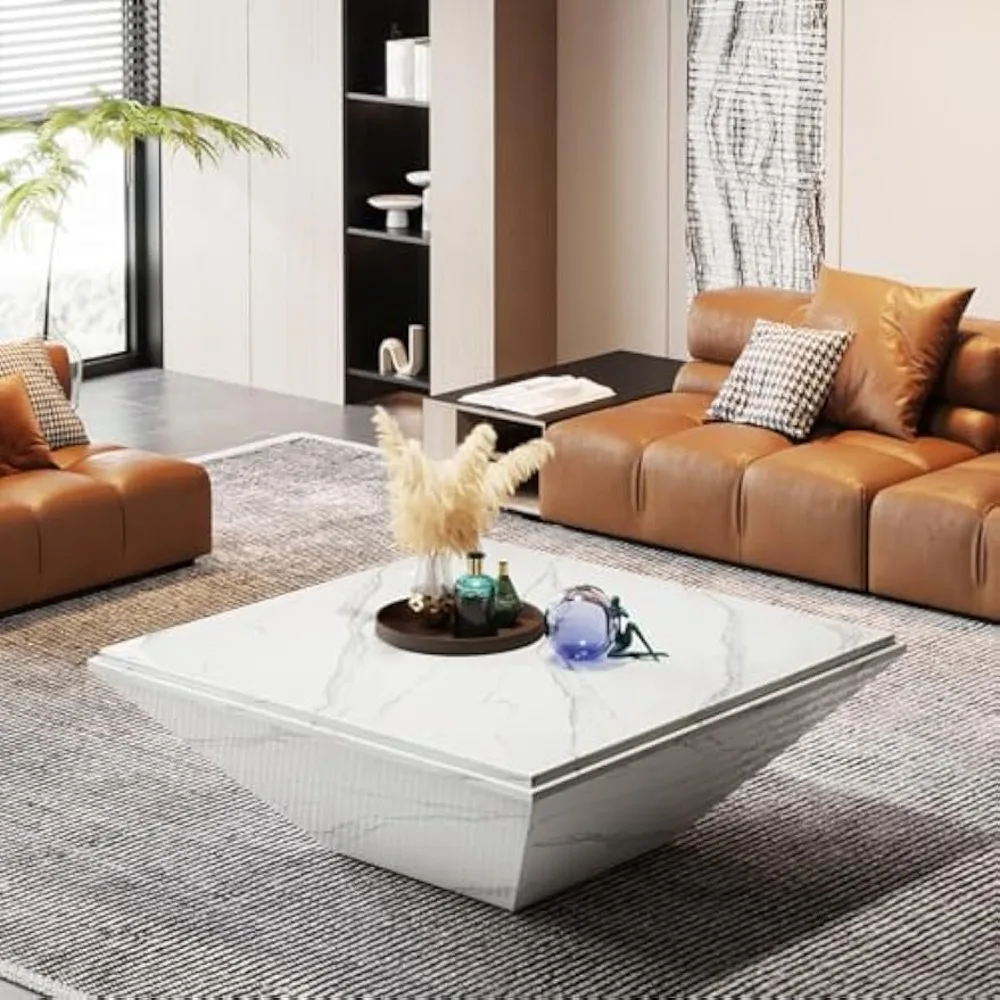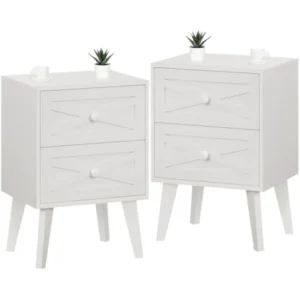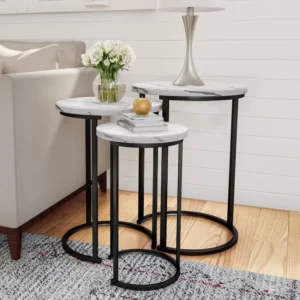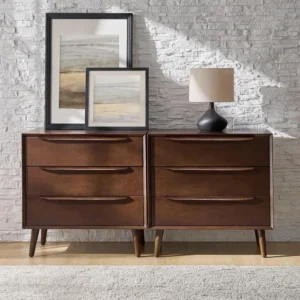The Essence of Mid-Century Modern Design in Marble Tables
Mid-century modern design represents one of the most influential periods in furniture history, spanning roughly from the 1940s through the 1960s. During this era, a perfect storm of post-war optimism, technological innovation, and shifting cultural values created a design movement that continues to captivate our imagination today.
The core principles that define mid-century modern furniture include:
- Functionality above all else, with forms that serve clear purposes
- Clean, uncluttered lines that avoid unnecessary ornamentation
- Organic shapes that reference natural forms while remaining modern
- Material honesty that celebrates rather than conceals construction materials
Marble emerged as a signature material during this period, representing the perfect marriage between natural luxury and modernist principles. The inherent beauty of stone with its unique veining patterns offered designers a way to incorporate nature’s artistry into otherwise geometric forms.
What makes these marble surface coffee table designs so enduring is how they balance opposing qualities—the coolness of stone with the warmth of complementary materials, the weight of marble with visually light supporting structures. These contrasts create visual interest while maintaining the clean aesthetic that defines mid-century modern table design.
Even today, these principles remain relevant in contemporary interiors, where the honest materiality and thoughtful proportions of mid-century marble tables continue to add sophistication to living spaces.
Marble as a Statement Material: Types and Characteristics
Mid-century designers embraced marble for several compelling reasons. The material brings visual weight and perceived value to furniture pieces, while its natural patterns add organic interest to otherwise clean-lined designs. Each piece of marble tells a unique geological story through its veining patterns, making every table a one-of-a-kind creation.
The most common marble varieties used in authentic mid-century pieces include:
| Marble Type | Visual Characteristics | Typical Applications |
|---|---|---|
| White Carrara | Light gray background with soft gray veining | Coffee tables, dining tables |
| Calacatta | Bright white background with dramatic gray or gold veining | Statement pieces, centerpiece tables |
| Nero Marquina | Deep black background with crisp white veining | Accent tables, dramatic dining tables |
| Emperador | Rich brown tones with varied veining | Side tables, console tables |
| Verde Alpi | Deep green with white and gray veining | Accent pieces, bar tables |
The distinctive characteristics of each marble type directly influenced design decisions. White marbles offered a bright, airy quality perfect for the open, light-filled spaces of mid-century homes. Black marbles created dramatic focal points, while colored varieties like green or brown marbles introduced subtle natural color that complemented wood elements.
The natural veining patterns in marble weren’t seen as imperfections but as intentional design elements to be showcased. Designers often selected specific marble slabs based on their unique patterns, sometimes even cutting and arranging the stone to highlight particularly beautiful sections of veining.
Understanding these ultimate guide marble types coffee tables helps in appreciating why certain designs have endured. At Hearth Forms, we carefully source marble for our mid-century modern marble top coffee tables to ensure they capture the authentic qualities valued by original mid-century designers.
Form and Silhouette: Geometric Precision Meets Organic Flow
Mid-century marble tables demonstrate a fascinating balance between mathematical precision and natural fluidity. The shapes chosen for table surfaces weren’t arbitrary but carefully considered for both aesthetic impact and practical function.
The predominant shapes used in mid-century marble tabletops include:
Round and oval forms: These shapes promote conversation flow and easy movement around the furniture. The absence of corners creates a softer presence, making round tables ideal for smaller spaces or rooms with children. The curved edges of these designs often echo other organic elements in mid-century interiors.
Rectangular and square forms: These shapes maximize surface area for practical use while maintaining clean lines. The strong geometry of rectangular tables aligns with architectural elements in the space, creating visual harmony and order.
Free-form and biomorphic shapes: Perhaps the most distinctive, these organic shapes reference natural forms like river stones, amoebas, or kidneys. These playful silhouettes showcase the mid-century fascination with organic modernism.
Tabletop thickness also served as an important design statement. Some designers opted for thin, delicate-looking marble slabs that appear to float above their bases, while others chose thicker cuts that emphasized the material’s substantial nature and created a more dominant presence.
The design features oval shaped tables often showcase how proportion and balance were carefully calculated—not too long or too wide—to create visually pleasing forms that still functioned well. Similarly, mid-century modern round coffee tables demonstrate how a simple circle can become distinctive through careful attention to height, diameter, and base design.
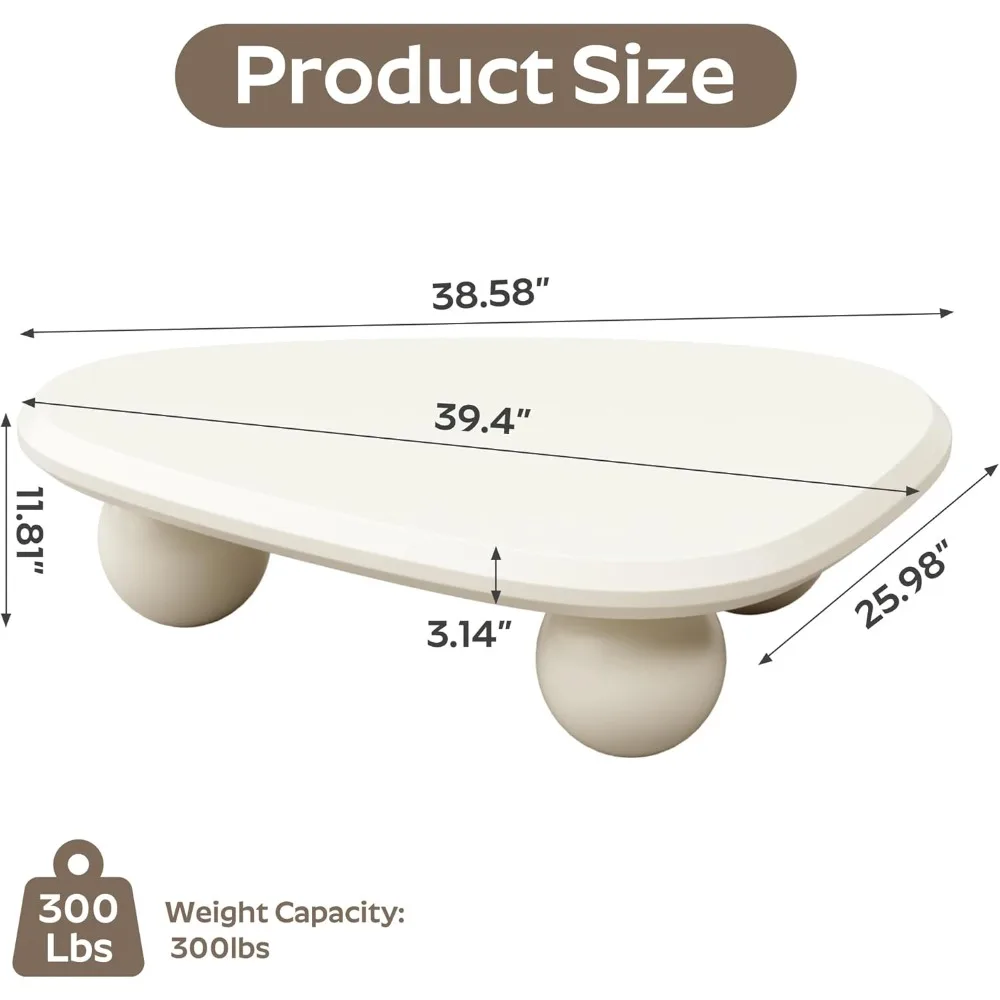
Structural Elements: Base Design and Material Contrast
The base of a mid-century marble table is far more than just structural support—it’s a critical design element that creates visual counterbalance to the substantial weight of the marble top. These base designs showcase the engineering ingenuity and design sensibility of the era.
Key mid-century table base designs include:
Slender tapered legs: These legs start slightly wider at the top and taper to a finer point at the floor. This subtle detail creates a sense of lightness and elegance that contrasts beautifully with the substantial marble top. Often arranged at angles that splay outward, these legs create stability while maintaining visual delicacy.
Pedestal bases: Central supports that rise from a stable foot to support the tabletop create a sculptural statement. These bases often feature organic curves or geometric precision that makes them artful elements in their own right.
Hairpin legs: Featuring thin metal rods bent into functional forms, these minimalist supports offer remarkable strength despite their visual lightness. The industrial simplicity of hairpin legs creates dramatic contrast with the luxury of marble.
X-bases and geometric frames: These structural supports provide exceptional stability while adding visual interest through intersecting lines and planes. The mathematical precision of these bases often creates fascinating shadow patterns that change throughout the day.
The intentional contrast between weighty marble tops and visually lighter bases is a hallmark of mid-century design ingenuity. This juxtaposition creates a sense of visual tension and balance that makes these pieces so compelling.
Our mid-century modern square coffee tables demonstrate how different base designs dramatically alter the character of a table, even when the tops share similar dimensions and materials.
Material Harmony: How Wood and Metal Complement Marble
The genius of mid-century marble table design often lies in thoughtful material combinations. Designers understood that marble rarely works best in isolation—its beauty is enhanced through deliberate contrast with complementary materials.
The most successful material combinations include:
Marble with warm woods: The pairing of cool, smooth stone with warm, tactile woods like teak, walnut, and oak creates a perfect temperature balance. The wood grain’s organic patterns complement marble’s natural veining, while providing visual warmth. Walnut was particularly favored for its rich, medium-dark tone that beautifully frames lighter marbles.
Marble with metals: Brass, steel, and bronze offer structural integrity while adding reflective qualities that marble lacks. Polished brass brings warmth and luxury, while stainless steel introduces industrial precision. The slender profiles possible with metal allow for designs that would be impossible with wood.
Marble with glass: In multi-tier designs, transparent glass shelves or elements create visual lightness and allow the marble to appear as if floating. This combination maximizes the display of the marble while adding functional surfaces.
These material pairings create textural contrasts that engage multiple senses. The cool, smooth touch of marble plays against the warmer, sometimes textured feel of wood, or the cool but different smoothness of metal. This sensory richness adds depth to the visual experience of the furniture.
Our collection of mid-century modern walnut coffee tables showcases how this classic wood beautifully complements various marble types, creating pieces that feel both substantial and refined.
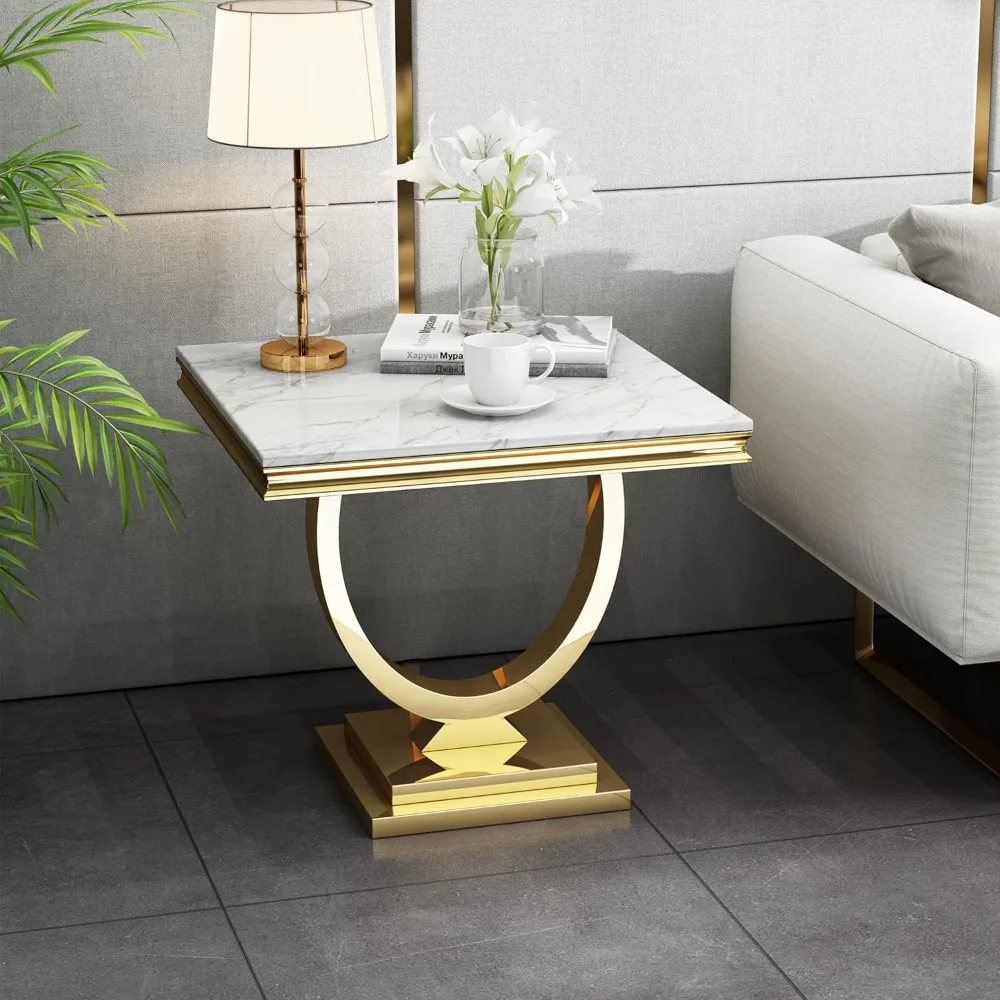
Finish and Detail: The Subtle Art of Surface Treatment
The surface treatment of marble significantly impacts both its appearance and practical use. Mid-century designers paid careful attention to these finishing details, understanding how they could enhance or diminish the material’s natural beauty.
Different marble finishes used in mid-century design include:
Polished: This reflective, mirror-like finish enhances the marble’s color depth and makes veining patterns more pronounced. Polished surfaces feel smoother to the touch and create a more formal, luxurious appearance. This finish was often preferred for dining and coffee tables meant to serve as focal points.
Honed: This matte finish absorbs rather than reflects light, creating a softer, more casual appearance. Honed marble feels slightly less smooth than polished and shows less dramatic veining contrast. This finish was often used in more relaxed settings or where glare might be problematic.
Textured: Though rarer in mid-century design, some pieces featured lightly textured finishes that added tactile interest. These specialized treatments were typically reserved for accent pieces or areas less likely to be touched frequently.
Edge treatments also served as important design elements:
Beveled edges: These angled edges catch the light differently from the main surface, creating a refined frame around the tabletop that adds visual interest without fussiness.
Bull-nosed edges: These fully rounded edges soften the table’s appearance and feel comfortable to the touch, making them practical for heavily used surfaces.
Knife edges: These sharply tapered edges create a sense of precision and thinness, making even substantial marble tops appear delicate and precise.
Choosing perfect marble finish coffee table involves understanding how these surface treatments affect both the visual impact and practical performance of the piece. The right finish depends on both aesthetic preferences and how the table will be used in daily life.
Functional Design: How Form Follows Function
Despite their undeniable beauty, mid-century marble tables were always designed with function at the forefront. The famous design principle “form follows function” is clearly evident in how these pieces were conceived and executed.
Practical considerations shaped marble table designs in several key ways:
Height specifications were carefully calibrated for different table types: coffee tables typically ranged from 16-18 inches high for comfortable use from sofas; dining tables maintained the standard 29-30 inch height for proper seating; side tables often matched chair arm heights for convenience.
Surface area requirements were determined by intended use: coffee tables provided enough space for serving and display without overwhelming the seating area; dining tables accommodated proper place settings with appropriate elbow room; side tables offered just enough surface for essential items.
Balance between durability and aesthetics meant selecting appropriate marble types and thicknesses for different applications. High-traffic surfaces might use more durable marbles with fewer soft veins, while show pieces could showcase more delicate varieties.
Innovative functional elements further elevated these designs:
- Nesting capabilities allowed tables to be tucked away when not needed
- Adjustable components responded to changing user needs
- Multi-purpose features maximized functionality in limited space
The design advantages large mid-century coffee tables demonstrate how functional requirements were never sacrificed despite the decorative nature of marble. Instead, the material’s beauty was harnessed to enhance the user experience while serving practical needs.
Table Typology: Design Elements Across Different Functions
Mid-century marble table design principles adapted beautifully across various table categories, each maintaining the movement’s core aesthetic while serving distinct functions.
Coffee Tables
– Served as central focus points in living spaces
– Often featured larger marble surfaces to create visual impact
– Typically paired with statement bases that anchored the piece
– Height and proportions carefully calculated for comfortable use from surrounding seating
– Frequently showcased the most dramatic marble patterns for maximum visual effect
Dining Tables
– Balanced the need for structural stability with maximizing available surface area
– Often featured pedestal bases to eliminate leg obstruction for diners
– Used thicker marble slabs to withstand the demands of dining
– Carefully considered the marble’s stain resistance and durability for food service
– Sometimes incorporated protective treatments without compromising aesthetics
Side Tables
– Created as smaller-scale versions that concentrated on material beauty in compact form
– Often featured more experimental shapes due to their accent nature
– Used proportion and scale to create balanced compositions
– Frequently paired with seating as functional companions
Console Tables
– Designed with wall-oriented applications in mind
– Emphasized slim profiles and visual lightness despite substantial materials
– Often served dual functions as display surfaces and storage solutions
– Created dramatic entries or visual dividers in open-plan spaces
Mid-Century Modern End Table Sets of 2, Mid-Century Modern Square Side & End Tables, Mid-Century Modern White Side & End Tables
$348.24 Select options This product has multiple variants. The options may be chosen on the product pageMid-Century Modern Nesting Side & End Tables, Mid-Century Modern Nesting Table Sets, Mid-Century Modern Round Side & End Tables
Price range: $239.35 through $273.06 Select options This product has multiple variants. The options may be chosen on the product pageMid-Century Modern End Table Sets of 2, Mid-Century Modern Walnut Side & End Tables
Price range: $978.89 through $1,957.38 Select options This product has multiple variants. The options may be chosen on the product pageMid-Century Modern Glass Top Coffee Tables, Mid-Century Modern Glass Top Side & End Tables
$460.58 Select options This product has multiple variants. The options may be chosen on the product pageMid-Century Modern Glass Top Coffee Tables, Mid-Century Modern Vintage Coffee Tables, Mid-Century Modern Vintage Side & End Tables
$725.36 Select options This product has multiple variants. The options may be chosen on the product pageMid-Century Modern Lift Top Coffee Tables, Mid-Century Modern Square Coffee Tables
$454.73 Select options This product has multiple variants. The options may be chosen on the product page
Our collection of mid-century modern side end tables demonstrates how these smaller pieces maintain the same design integrity as their larger counterparts while adapting to more compact applications.
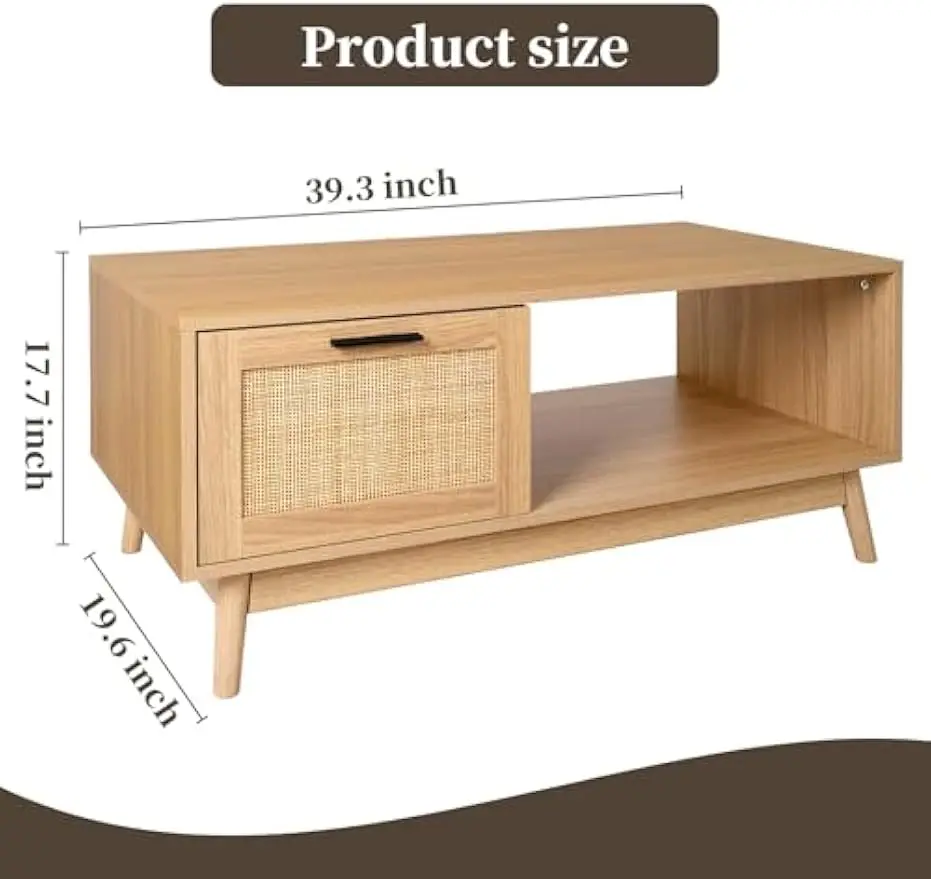
Authenticity Markers: Identifying True Design Elements
For collectors and enthusiasts, recognizing authentic mid-century design elements in marble tables involves attention to several key factors:
Material Quality and Selection
– Authentic pieces used natural marble with genuine veining patterns
– Marble types aligned with those historically available during the period
– Stone cutting and matching showed careful attention to pattern flow
– Material thickness appropriate to the design’s era and style
Construction Techniques
– Joinery methods between marble and other materials show precision and intention
– Edge finishing demonstrates hand craftsmanship with consistent detailing
– Support structures engineered appropriately for the stone’s weight
– Hardware, if visible, matches the period’s available technology
Proportional Consistency
– Adherence to mid-century proportional guidelines for height-to-width ratios
– Appropriate scale relationships between tops and bases
– Thickness of materials consistent with period manufacturing capabilities
– Visual balance achieved through mathematical relationships
Material Balance
– Thoughtful showcase of marble’s natural beauty without overwhelming the design
– Structural integrity maintained despite visual lightness
– Complementary materials selected to enhance rather than compete with the stone
When evaluating both vintage pieces and contemporary interpretations, these markers help distinguish thoughtfully designed tables from those that merely appropriate the style superficially. True mid-century marble coffee tables demonstrate an understanding of the design principles that made the original pieces so enduring.
Styling Context: Placing Marble Mid-Century Tables in Modern Interiors
The enduring appeal of marble mid-century tables lies partly in their remarkable versatility within contemporary interiors. These pieces can serve as bridges between different styles or as anchoring elements in cohesive design schemes.
For successful integration into modern spaces:
Pair with complementary furniture styles
– Combine with contemporary pieces that share clean lines and honest materials
– Create eclectic interest by mixing with carefully selected traditional elements
– Use with other mid-century pieces for a cohesive look without appearing themed
Balance with textiles and accessories
– Soften marble’s hard surface with textured fabrics on surrounding furniture
– Echo marble colors in accessories without matching too precisely
– Add warmth through wood tones, brass accents, and natural fibers
– Create visual stability by placing weighty objects on the table’s surface
Consider lighting to enhance marble qualities
– Position tables where natural light can highlight veining patterns
– Use directional lighting to create interesting shadows from table bases
– Avoid harsh overhead lighting that can flatten marble’s visual depth
– Consider how evening lighting changes the stone’s appearance
The neutral quality of marble allows for versatile color schemes around it. White marbles can brighten darker spaces, while darker stones add grounding weight to lighter rooms. Each room type presents different opportunities—dining rooms can showcase larger marble statements, while living rooms benefit from the textural contrast marble provides against upholstery.
For specific guidance on creating balanced compositions around these tables, our guide to styling marble coffee tables mid-century offers practical advice for various interior styles.
Preservation Considerations: Maintaining Design Integrity
Preserving the beauty and integrity of marble mid-century tables requires understanding both the material’s needs and the design’s original intent.
Cleaning Methods for Different Finishes
– Polished surfaces benefit from gentle, pH-neutral cleaners that maintain shine
– Honed finishes need different care to prevent uneven appearance
– All marble surfaces should be wiped promptly after spills, especially acidic substances
– Avoid abrasive cleaners that can damage the stone’s finish
Protection Against Common Damage
– Use coasters under glasses to prevent etching from acidic beverages
– Apply appropriate sealers based on the specific marble type and use
– Consider glass tops for valuable pieces that see heavy use
– Protect from direct sunlight which can fade some colored marbles over time
Appropriate Repair Approaches
– Minor scratches in polished surfaces can often be buffed out
– Etching may require professional restoration to maintain design integrity
– Chips should be repaired by specialists using matching materials
– Always consider the piece’s historical value before aggressive restoration
Interestingly, some patina development can actually enhance rather than detract from mid-century marble tables. The subtle aging of stone and complementary materials often adds character and authenticity to these pieces, telling the story of their use through time.
Finding the right balance between use and preservation allows these beautiful designs to remain functional while maintaining their integrity. For specific techniques, our guide on cleaning maintaining marble coffee table provides detailed care instructions for different marble varieties.
Why These Elements Endure: The Timeless Appeal of Marble Mid-Century Design
The enduring charm of marble mid-century tables stems from their perfect balance of seemingly contradictory qualities. They are simultaneously substantial yet visually light, natural yet precisely geometric, luxurious yet functional, historic yet eternally contemporary.
These specific design elements continue to resonate because they embody principles that transcend trends:
Material honesty celebrates rather than conceals the inherent properties of marble and complementary materials. This authenticity connects us to the natural world in our increasingly digital lives.
The balance between organic natural material and clean modernist lines creates visual interest without chaos—offering both complexity and clarity in a single piece.
The versatility of these designs allows them to adapt to evolving interior styles. Whether in minimalist apartments, traditional homes, or eclectic spaces, marble mid-century tables find their place without looking out of context.
Perhaps most importantly, the functional designs continue to serve contemporary living patterns. Despite being conceived decades ago, these tables meet our needs for surfaces that are both beautiful and useful.
The aesthetic appeal marble top coffee tables hasn’t diminished because good design, thoughtfully conceived, doesn’t expire. These pieces represent more than just furniture—they’re a testament to the enduring power of thoughtful design principles applied to natural materials with respect and creativity.

